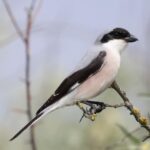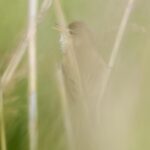A Private Tour today, in North Norfolk. As a journey east along the coast had already been made earlier in the week, we decided to head west. It was a lovely bright, clear, sunny morning – a perfect day to be out birding.
A request was made to look for Shore Larks. None of the regular wintering birds had been seen for a week, but they have gone missing and then reappeared before, so it was worth a look at least. And Burnham Overy is a great place to walk, with lots of other things to see on the way. We parked at Overy Staithe and could hear the plaintive calls of Grey Plovers as we got out of the car. Two were on the mud in the harbour, looking resplendent in the sunshine, along with several Ringed Plovers. Nearby, in the harbour channel, were a pair of Red-breasted Mergansers.
 Red-breasted Merganser – a pair were in the harbour channel
Red-breasted Merganser – a pair were in the harbour channel
There were lots more waders along the edges of the channel as we walked out along the seawall. As well as more Ringed Plovers and Grey Plovers, there were lots of Redshanks, chasing each other round now and calling, plus a handful of Dunlin. A flock of dark, blackish-brown Turnstones wheeled round landed on the sandbank and in amongst them a very pale silvery grey wader was a single Sanderling.
 Grey Plover – there were plenty along the edges of the harbour channel
Grey Plover – there were plenty along the edges of the harbour channel
There are normally a few godwits here too, but there was no sign of any out on the mud this morning. Predictably, the Black-tailed Godwits were out on the wet grass the other side of the seawall, feeding in amongst the flocks of Wigeon and Brent Geese. Several of them are now just starting to get their first brighter orange feathers of summer plumage. More surprisingly, the Bar-tailed Godwits were out on the grass as well today – they normally prefer the salty mud. It had rained hard overnight and there were actually lots of waders around the pools and puddles – lots of Curlew, a big flock of Dunlin and a single Ruff – which were all spooked repeatedly and whirled round in the sky before landing back down.
The Brent Geese were commuting between the harbour channel, the reedbed pool and the grazing marshes. A large group of them settled quite close to the seawall, so we stopped for a quick scan through them. It didn’t take long to find the Black Brant x Dark-bellied Brent hybrid in with them. Even looking into the sun, we could see that it was sporting a much more obvious, more solid white flank patch and bolder white collar than the regular Dark-bellied Brent Geese. Up close, through the scope, we could see that its back and belly were subtly darker than the others, but not black enough to be a pure Black Brant. This bird has been returning to the same fields here every winter for several years now and can normally be found in with the Brent flocks here, a pitfall for the unwary.
 Black Brant hybrid – in with the regular wintering Dark-bellied Brents
Black Brant hybrid – in with the regular wintering Dark-bellied Brents
Further out towards the dunes, we could see a Red Kite circling lazily. It flushed the large flock of Golden Plovers lurking out in the grass and they whirled round, catching the sun and flashing alternately dark and white as they turned. The Red Kite landed and we could see there was a second bird already down on the ground. A third Red Kite was flying along the dunes to the west, out towards Gun Hill. The sunny weather was presumably getting the raptors out.
As we got out through the dunes to the beach, we stopped for a quick scan of the sea. A couple of Great Crested Grebes were already coming into summer plumage, but the Red-throated Diver was not, still very white-faced in its winter garb. A couple more Red-throated Divers flew past distantly. The beach was looking stunning in the early spring sunshine and, even better, as we turned to make our way west we had it all to ourselves at first – a magical place to be.
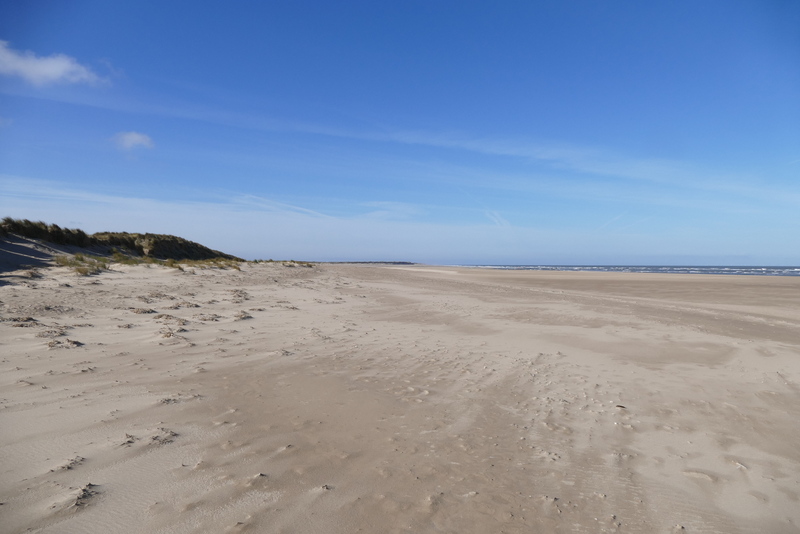 Burnham Overy – we had the beach to ourselves at first
Burnham Overy – we had the beach to ourselves at first
As we walked along the beach, we could hear Pink-footed Geese calling from out towards the saltmarsh and a skein of about 150 birds appeared in the sky from behind the dunes. The numbers of Pink-footed Geese have already dropped substantially, with the peak here for the winter normally between November and early February. Many have already departed on their way further north, where they will stop off to feed up before continuing on to Iceland for the summer. These birds seemed to be on their way, taking advantage of the weather, as they flew out over Scolt Head Island towards the sea.
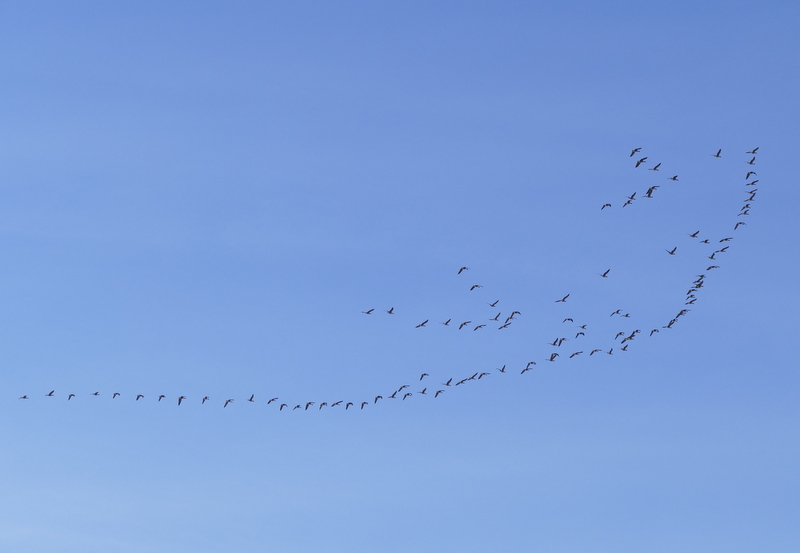 Pink-footed Geese – on their way back towards Iceland after the winter
Pink-footed Geese – on their way back towards Iceland after the winter
There were quite a few waders up on the top of the beach, roosting around the high tide line. Several Ringed Plovers and Sanderlings flew off down towards the shore as we walked along. Then we noticed a couple of smaller birds picking around the piles of dead seaweed and saltmarsh vegetation ahead of us and a quick look confirmed they were Snow Buntings.
We edged our way towards them so we could get a better look. Snow Buntings can be remarkably tame if approached with care and not startled and these were no exception. We eventually found six of them today, four together here and another two further along. As we stood quietly, they made their way quietly right towards us. Great birds!
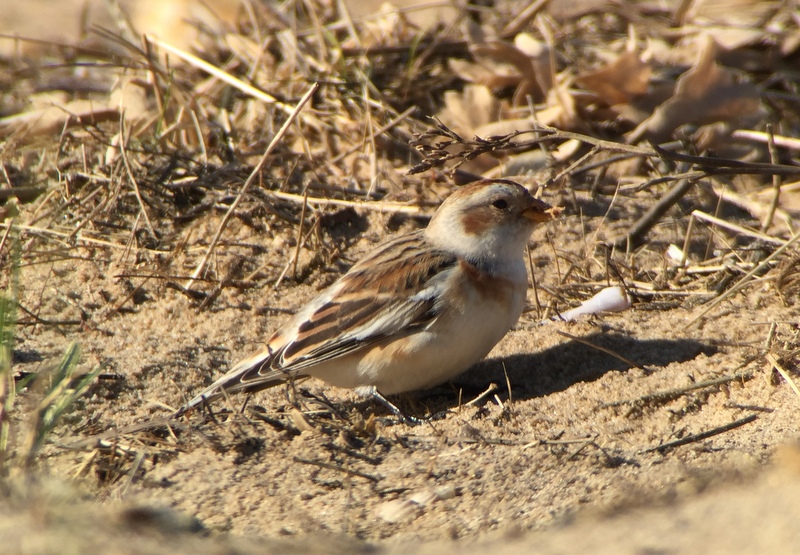
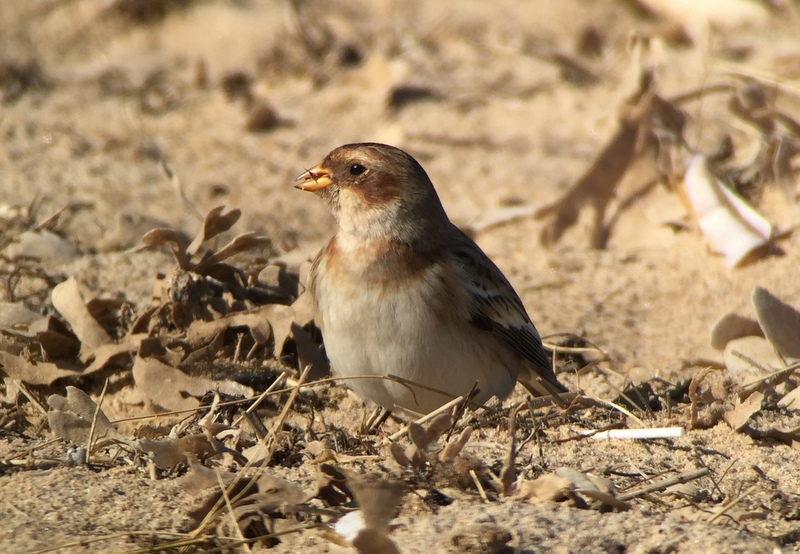
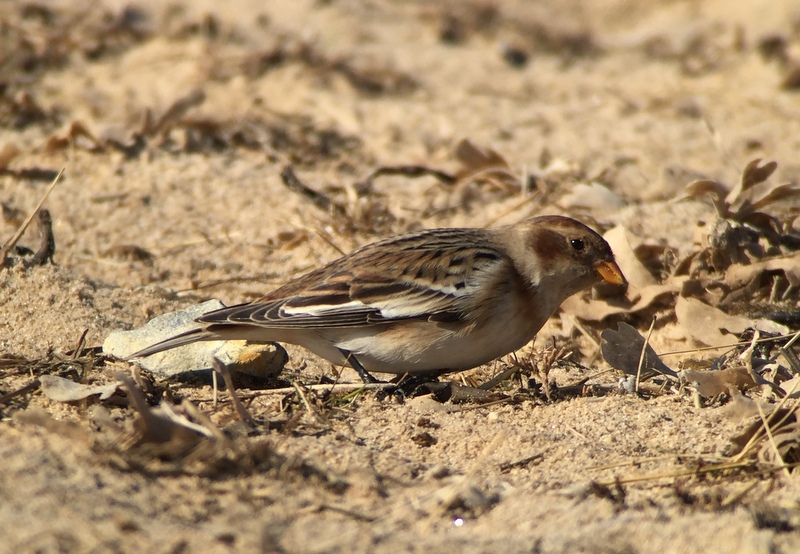 Snow Buntings – six were on the beach today
Snow Buntings – six were on the beach today
We watched the Snow Buntings feeding along the edge of the dunes for some time. Eeventually we had to tear ourselves away, as some dog walkers were approaching behind us and we wanted to explore the rest of the beach before it got disturbed. Despite being first out along the beach, there was no sign of the Shore Larks here again today. They were getting moved about constantly by dogs and people last time we saw them, so perhaps it is no surprise they have chosen somewhere quieter to feed or moved on already. Out in the harbour channel from beyond Gun Hill we could see several more Red-breasted Mergansers and a single Goldeneye. A flock of waders roosting on the mud beyond was mostly Grey Plovers and Dunlins but with a couple of Knot in there too.
On the walk back, there were even more raptors up than there had been on the way out. As well as several Red Kites still, there were numerous Marsh Harriers and Common Buzzards circling in the clear blue sky. In the harbour channel, normal service was resumed as the Bar-tailed Godwits flew back out onto the mud. A Mediterranean Gull flew over calling, and we managed to pick it out high in the sky, flashing its pure white wing tips as it circled.
We made a brief stop at Brancaster Staithe on our way past, as we continued on our way west. As usual, there was a good selection of waders around the harbour. Several Bar-tailed Godwits were feeding along the waters edge and a single Black-tailed Godwit was on the mud nearby. Turnstones were running around the car park between the cars. More surprising was a single Common Snipe in one of the muddy channels. Further over, towards Scolt Head, three more Red Kites were spiralling up on the edge of the water. We often get a movement of Red Kites along the coast on warm days in the spring, and it seemed like this was happening today.
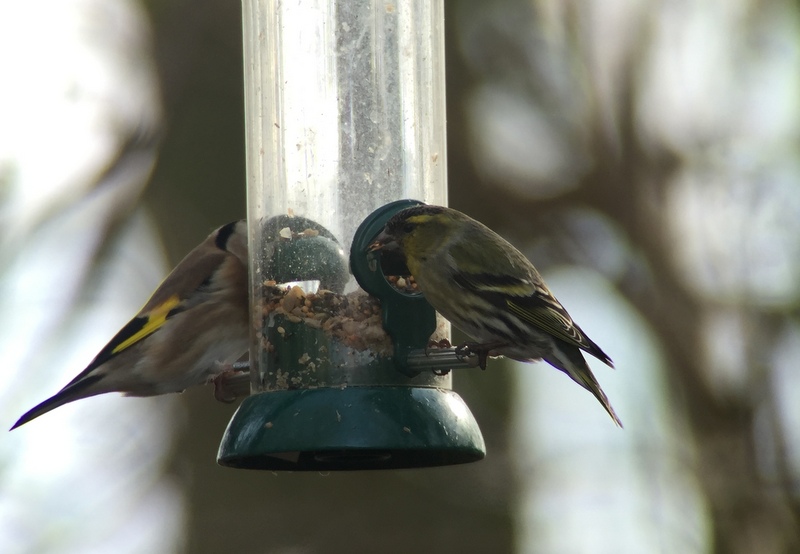 Siskin – managed to find a place on the busy feeders
Siskin – managed to find a place on the busy feeders
After lunch at Titchwell, we walked out onto the reserve. The feeders around the visitor centre were packed with finches, as usual. A couple of Siskin managed to find a space on the feeders in front, amongst all the Chaffinches, Greenfinches and Goldfinches. Round on the other side of the visitor centre, a female Brambling was hiding in the tree above the feeders there, before dropping down briefly grabbing a seed and disappearing back into the bushes to eat it.
The Water Rail was in its usual place in the ditch beside the main path. It was slightly hidden from view at first, lurking under the overhanging vegetation at the back, but gradually worked up the courage to come out into view, digging around in the damp rotting leaves. A Song Thrush flew down and started feeding nearby too.
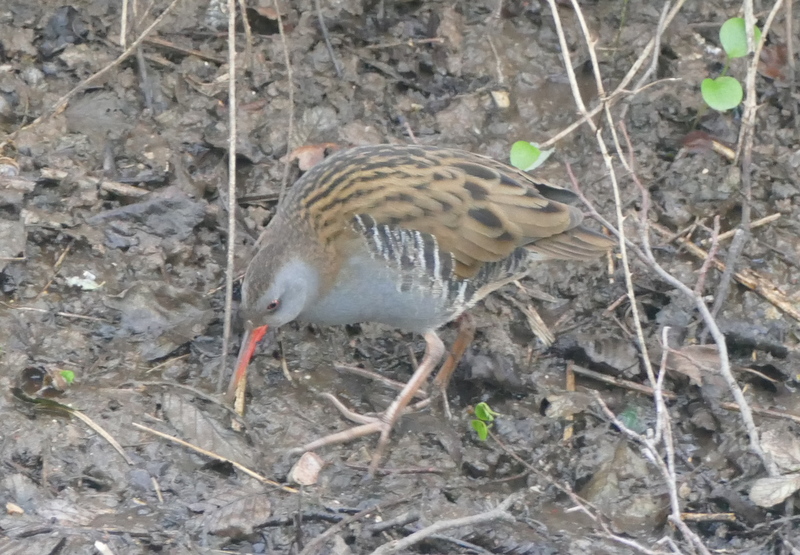 Water Rail – in its usual ditch
Water Rail – in its usual ditch
There were lots of pipits and quite a few Pied Wagtails around the still dried-up grazing meadow ‘pool’ today. Most of the pipits were Rock Pipits, oily green above and dirty below, so we had a good look at a couple of those first. Then we found a single cleaner, whiter Water Pipit towards the back. We got it in the scope and had three different pipits together at one point, as well as Water and Rock, a single Meadow Pipit walked into the same view as well!
While we were admiring the pipits, we could hear a Kingfisher calling from the reeds right in front of us. It was a devil of a job to see at first, although it perched up in a tangle where we could just get onto it through the swaying reeds in front. Eventually, it flew out of the reeds, across the path and perched up in full view in a bush on the edge of the main reedbed briefly, before flying away down one of the channels.
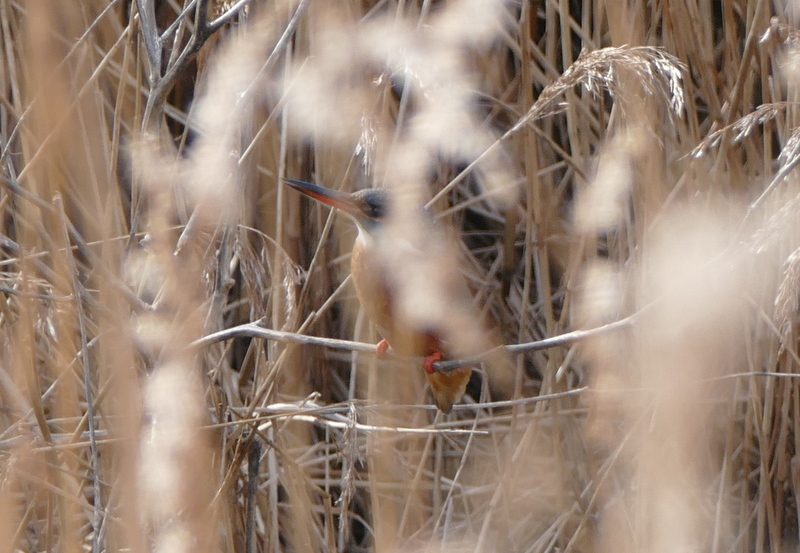 Kingfisher – hiding in the reeds
Kingfisher – hiding in the reeds
There was a bit more activity on the reedbed pool today. As well as the regular Greylag Geese and Coot, there was a small group of Tufted Ducks at the back and a single female Common Pochard diving in front of them. Three Red-crested Pochards swam out from behind the reeds, the two drakes now looking particularly replendent with their bright orange punk haircuts and coral red bills. A single Great Crested Grebe in smart summer plumage swam out from the reeds as well.
Out on the freshmarsh, the water level is still very low and the management work is now underway. One of the islands is being fenced in to protect the breeding Avocets from mammalian predators, having not raised a successful brood here for the last two years. With all the disturbance, there was still a remarkable number of birds on here, although much quieter than normal. As well as a smattering of ducks, mainly Teal and Gadwall, there were big flocks of Golden Plover and Dunlin out on the exposed mud.
Given all the disturbance, we moved swiftly on to look at the Volunteer Marsh. As well as lots of Redshank, Curlew and Shelduck plus several Grey Plover and a couple of Ringed Plovers, much as usual, a couple of Black-tailed Godwit were feeding in the channel right by the path. It was great to see them up close. A little further along, three Avocets were doing the same.
 Black-tailed Godwit – starting to show a few orange summer feathers
Black-tailed Godwit – starting to show a few orange summer feathers
Out on the Tidal Pools, there were several Bar-tailed Godwits and we spent a little time looking at the differences between the two species. At one point, we even managed to get Black-tailed and Bar-tailed Godwit in the same view together, providing a really good opportunity to compare them. There was also a nice close Knot, dumpy and grey, a much better view than the ones we had seen distantly earlier. Further along, there were not as many ducks on the pools today, just a couple of female Pintail and a single Goldeneye.
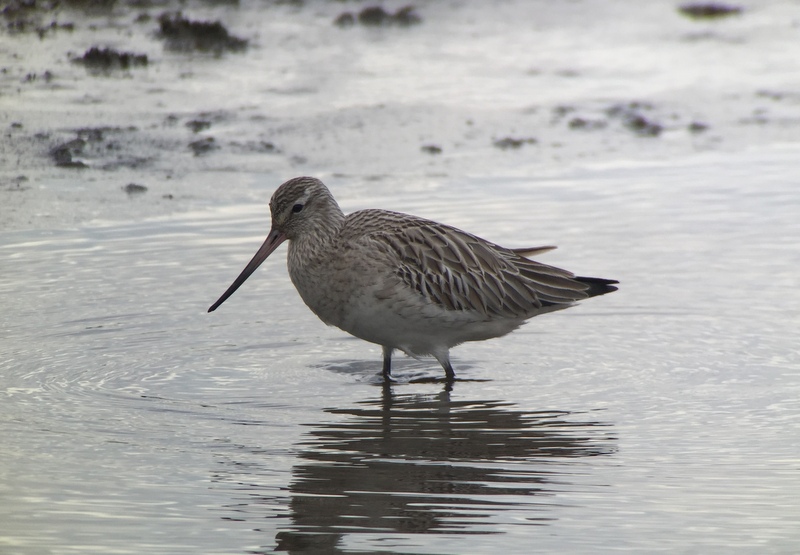 Bar-tailed Godwit – several were on the Tidal Pools
Bar-tailed Godwit – several were on the Tidal Pools
The tide was still quite high out on the beach. A quick scan of the sea revealed four Common Scoters fairly close inshore so we got those in the scope first to have a good look at them. Further out, a long slick of black on the sea revealed itself to be several hundred more Common Scoters diving offshore for shellfish. There were lots of Great Crested Grebes still out on the water, but mostly a long way out given the fairly calm conditions today, but no sign of any other grebes off here today.
On the walk back, we spotted a Barn Owl hunting distantly over the back of the reedbed by the east bank. It perched on the top of a post for a few seconds so we could get it in the scope. Further along, another distant Barn Owl appeared, way over towards Thornham village. It was only when we were almost back to the visitor centre that we found a closer Barn Owl – there is usually one hunting over the grazing meadow here late in the day. It did a quick circuit of the grass, dropping down to the ground at one point, before landing on one of the fence posts.
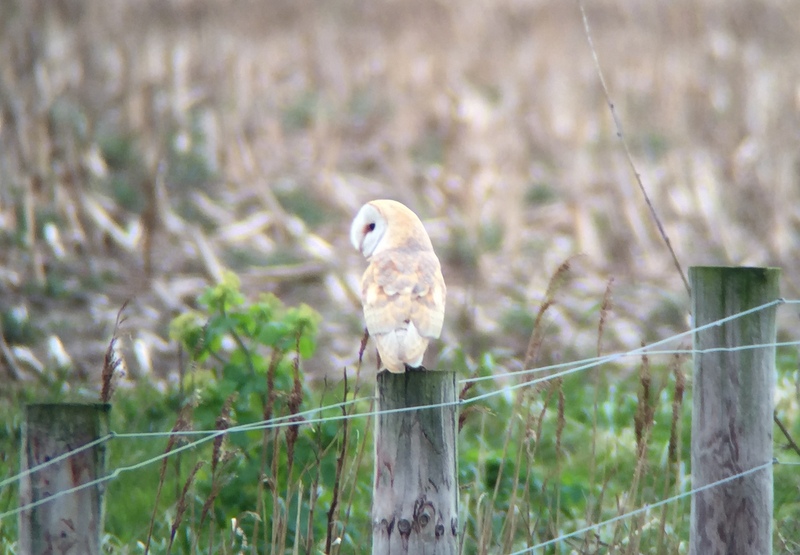 Barn Owl – hunting over the grazing meadow as usual
Barn Owl – hunting over the grazing meadow as usual
It had clouded over by this stage, late in the afternoon, but we had enjoyed such fabulous weather for most of the day, so we couldn’t complain. We wanted to make a quick circuit round the back of Titchwell to look for Rough-legged Buzzards, hoping that they might be out hunting here. The birds which have spent much of the winter around Choseley had not been reported for almost a week now, but one had been seen over the reserve earlier in the morning. When something has not been reported for a day or two, people often stop looking, so we reasoned they may still be in the area.
As we drove up past the drying barns,we stopped to scan the fields. There are always lots of Brown Hares here, but at this time of day they were all busy feeding rather than boxing. While we were looking at one, the head of a Grey Partridge appeared out of the winter wheat behind it – we could see its orange face. There was no shortage of black and white-faced Red-legged Partridges up here too, the lucky ones which have managed to survive the shooting season.
We swung round onto Chalkpit Lane and stopped to scan the trees where the Rough-legged Buzzards had liked to perch through the winter. Bingo! There was a Rough-legged Buzzard! We hopped out of the car and got it in the scope quickly, noting its very pale whitish head and contrasting blackish belly patch. Then it dropped out of the hedge and flew low across the field and over the road in front of us. We could see its very white tail with a clear black terminal band as it swooped down at something in the field. It flew along the hedge for some way, before disappearing over the other side and out of view. Fantastic stuff, a great way to end the day.
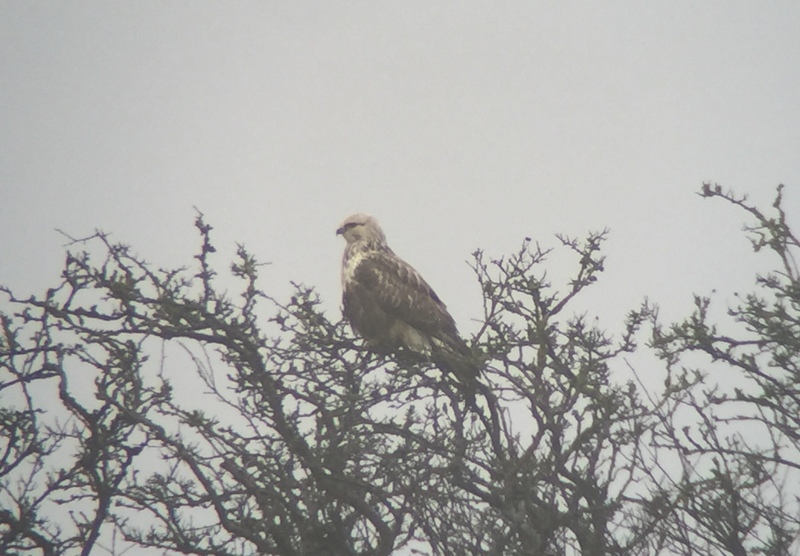 Rough-legged Buzzard – here’s one from earlier in the winter
Rough-legged Buzzard – here’s one from earlier in the winter
There was still one surprise in store for us. As we drove up along Chalkpit Lane towards the main road, we could see a funny shape in the middle of the road in front of us. It was not dissimilar in size to a partridge, but was clearly the wrong shape. As we got closer we could see it was a Woodcock! We slowed down and it walked up into the verge as we pulled up right alongside. It was clearly rather surprised, because it stood in the grass for several seconds only a metre or so from the car. Stunning. Then it came to its senses and flew up and over the hedge.
We headed for home, with another Barn Owl on the way back rounding things off nicely.
